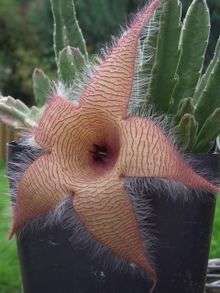Stapelia gigantea
| Stapelia gigantea | |
|---|---|
 | |
| Carrion plant flower | |
| Scientific classification | |
| Kingdom: | Plantae |
| (unranked): | Angiosperms |
| (unranked): | Eudicots |
| (unranked): | Asterids |
| Order: | Gentianales |
| Family: | Apocynaceae |
| Subfamily: | Asclepiadoideae |
| Tribe: | Stapeliae |
| Genus: | Stapelia |
| Species: | S. gigantea |
| Binomial name | |
| Stapelia gigantea N.E.Br. | |
Stapelia gigantea is a species of flowering plant in the family Apocynaceae, native to south eastern Africa. Growing up to 20 cm (8 in) tall, it is a clump-forming succulent with erect green stems 3 cm (1 in) thick. In summer, it bears large star-shaped five-petalled flowers up to 25 cm (10 in) in diameter. The flowers are red and yellow, wrinkled, with a silky texture and fringed with hairs, that can be as long as 8 mm (0.3 in). They have the smell of rotting flesh,[1] in order to attract the flies which pollinate them. Despite the foul odor of its flower, S. gigantea can act as an appetite suppressant in humans.[2] The plant is commonly referred to as Zulu giant,[3] carrion plant or toad plant (although the name "carrion plant" can also refer to Stapelia grandiflora). Stapelia gigantea sometimes also goes by the name of Stapelia nobilis or Stapelia marlothii.
There have been several proposed reasons for the size of the flowers of S. gigantea. First, it is possible that they are large to attract the flies that pollinate it.[4] The largeness and color of the flower combined with the carrion smell may serve to make the flies think that it is a dead carcass and be more likely to visit it.[4][5] It has also been proposed that these large flowers could work as thermal regulators, much like the large ears of a Fennec fox.
Due to its tender nature and intolerance of extended freezing, this plant is usually grown as a houseplant in temperate zones. It has gained the Royal Horticultural Society's Award of Garden Merit.[6]
S. gigantea can become an invasive plant when introduced in arid and semi-arid environments, although it has been found to facilitate the recruitment of nurse-dependent native taxa.[7]
References
- ↑ RHS A-Z encyclopedia of garden plants. United Kingdom: Dorling Kindersley. 2008. p. 1136. ISBN 1405332964.
- ↑ Corley, David Gregory; Miller, James (Mar 7, 2006), Plant derived or derivable material with appetite suppressing activity, retrieved 2016-09-28
- ↑ "Stapelia gigantea". Natural Resources Conservation Service PLANTS Database. USDA. Retrieved 1 December 2015.
- 1 2 Johnson, and Jurgens. "Convergent evolution of carrion and faecal scent mimicry in fly-pollinated angiosperm flowers and a stinkhorn fungus.". South African Journal of Botany. 76.
- ↑ Davis Endress, and Baum. "The evolution of floral gigantism". Current opinion in plant biology. 11.
- ↑ "RHS Plant Selector - Stapelia gigantea". Retrieved 5 July 2013.
- ↑ Herrera, Ileana; Ferrer-Paris, José R.; Hernández-Rosas, José I.; Nassar, Jafet M. (2016). "Impact of two invasive succulents on native-seedling recruitment in Neotropical arid environments" (PDF). Journal of Arid Environments. 132: 15–25. doi:10.1016/j.jaridenv.2016.04.007. Retrieved 6 May 2016.
- Stems
- Stems closeup
- Flower and bud